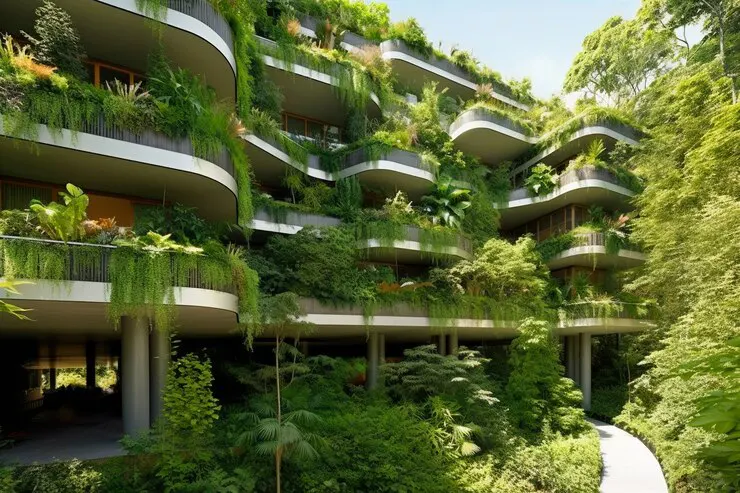As awareness of environmental issues continues to grow, more and more homeowners are looking for ways to make their homes more sustainable. Building an eco-friendly home not only reduces your carbon footprint but also offers long-term benefits such as lower energy costs, improved indoor air quality, and a healthier living environment.
Whether you’re building a new home from the ground up or planning a renovation, incorporating sustainable features into your design is a smart choice for both the planet and your wallet. In this blog, we’ll explore some of the key eco-friendly features to consider when building a sustainable home.
Energy-Efficient Insulation and Windows
One of the most effective ways to reduce energy consumption in your home is to invest in high-quality insulation and energy-efficient windows. Proper insulation helps maintain a consistent indoor temperature by reducing heat loss in the winter and heat gain in the summer. This means your heating and cooling systems won’t have to work as hard, resulting in lower energy bills and a reduced carbon footprint.
When choosing insulation, consider eco-friendly materials such as recycled denim, wool, or cellulose, which are not only effective but also have a lower environmental impact than traditional options like fiberglass. Additionally, make sure your home is well-sealed to prevent drafts and ensure maximum efficiency.
Energy-efficient windows are another important component of a sustainable home. Look for double or triple-glazed windows with low-emissivity (Low-E) coatings that reflect heat while allowing natural light to enter. These windows help keep your home comfortable year-round and can significantly reduce energy costs.
Solar Panels and Renewable Energy
Incorporating renewable energy sources into your home is one of the most impactful ways to reduce your reliance on fossil fuels and decrease your environmental footprint. Solar panels are a popular choice for homeowners looking to harness the power of the sun to generate electricity. While the initial investment can be significant, the long-term savings on energy bills and potential tax incentives make solar panels a worthwhile addition to any sustainable home.
In addition to solar panels, consider other renewable energy options such as wind turbines or geothermal systems, depending on your location and the specifics of your property. These systems can further reduce your dependence on the grid and provide clean, renewable energy for your home.
Water Conservation Features
Water conservation is a key aspect of sustainable home building, especially in areas prone to drought or water shortages. There are several eco-friendly features you can incorporate into your home design to reduce water usage and promote conservation.
Low-flow fixtures, such as faucets, showerheads, and toilets, use less water without sacrificing performance. These fixtures can significantly reduce your household water consumption, helping you save both water and money on your utility bills.
Another water-saving feature to consider is a rainwater harvesting system, which collects and stores rainwater for use in irrigation, landscaping, and even household chores like washing your car. By utilizing rainwater, you can reduce your reliance on municipal water supplies and make your home more self-sufficient.
Greywater recycling systems are also worth considering. These systems capture water from sinks, showers, and washing machines, treat it, and reuse it for irrigation or flushing toilets. By recycling greywater, you can further reduce your household’s water consumption and minimize wastewater production.
Sustainable Building Materials
The materials you choose for your home’s construction can have a significant impact on its overall sustainability. Opting for sustainable building materials not only reduces the environmental impact of your home but also ensures that it’s built to last.
Look for materials that are renewable, recycled, or locally sourced. For example, bamboo is a fast-growing, renewable resource that makes an excellent alternative to traditional hardwood flooring. Recycled steel, reclaimed wood, and concrete with recycled content are other eco-friendly options that can be used in various aspects of your home’s construction.
In addition to choosing sustainable materials, consider the durability and longevity of the products you select, such as fire rated access doors. High-quality, long-lasting materials may have a higher upfront cost but will save you money in the long run by reducing the need for repairs and replacements.
Green Roofing and Landscaping
The exterior of your home offers several opportunities to enhance its sustainability, starting with the roof. Green roofing systems, also known as living roofs, involve planting vegetation on the roof’s surface. These roofs provide natural insulation, reduce stormwater runoff, and help lower urban heat island effects. Green roofs also support biodiversity by providing habitats for birds, insects, and other wildlife.
If a green roof isn’t feasible for your home, consider installing a cool roof instead. Cool roofs are designed to reflect more sunlight and absorb less heat than standard roofs, helping to keep your home cooler and reducing the need for air conditioning.
Landscaping also plays a important role in sustainable home building. Opt for native plants that require minimal water and maintenance, and design your garden with xeriscaping principles in mind. This approach emphasizes water-efficient landscaping practices, such as grouping plants with similar water needs and using mulch to retain soil moisture.
Additionally, consider incorporating permeable paving materials for driveways and walkways. These materials allow rainwater to filter through the ground, reducing runoff and replenishing groundwater supplies.
Indoor Air Quality and Non-Toxic Finishes
Creating a healthy indoor environment is an important aspect of sustainable home building. Poor indoor air quality can lead to a range of health issues, including respiratory problems and allergies. To promote a healthier living space, focus on using non-toxic finishes and materials that don’t release harmful chemicals into the air.
Look for low-VOC (volatile organic compound) or VOC-free paints, stains, and sealants, which emit fewer toxic fumes compared to conventional products. Additionally, choose natural or organic materials for flooring, cabinetry, and furniture, such as hardwood, cork, or natural linoleum, which are less likely to off-gas harmful chemicals.
Proper ventilation is also essential for maintaining good indoor air quality. Ensure that your home’s HVAC system includes high-efficiency air filters and consider installing a whole-house ventilation system to keep fresh air circulating throughout the home.
Smart Home Technology for Energy Efficiency
Smart home technology is becoming increasingly popular for its ability to enhance energy efficiency and make homes more sustainable. Smart thermostats, for example, allow you to control your home’s heating and cooling systems remotely, optimizing energy use based on your schedule and preferences. These devices can learn your habits over time and make automatic adjustments to reduce energy consumption without sacrificing comfort.
Smart lighting systems offer similar benefits by allowing you to control lighting levels and schedules from your smartphone or voice-activated assistant. You can program lights to turn off when not in use or adjust brightness levels based on natural light availability, further reducing your energy usage.
Other smart home devices, such as energy-efficient appliances, water heaters, and irrigation systems, can also be integrated into your sustainable home design, helping you monitor and manage your home’s energy and water consumption more effectively.
Conclusion
Building a sustainable home is an investment in both your future and the planet. By incorporating eco-friendly features such as energy-efficient insulation, renewable energy sources, water conservation systems, and sustainable building materials, you can create a home that minimizes its environmental impact while maximizing comfort and efficiency. Whether starting from scratch or renovating an existing home, these sustainable features will help you build a greener, healthier, and more cost-effective living space for you and your family. Embrace the benefits of sustainable home building and contribute to a more sustainable future for future generations.




No Comment! Be the first one.